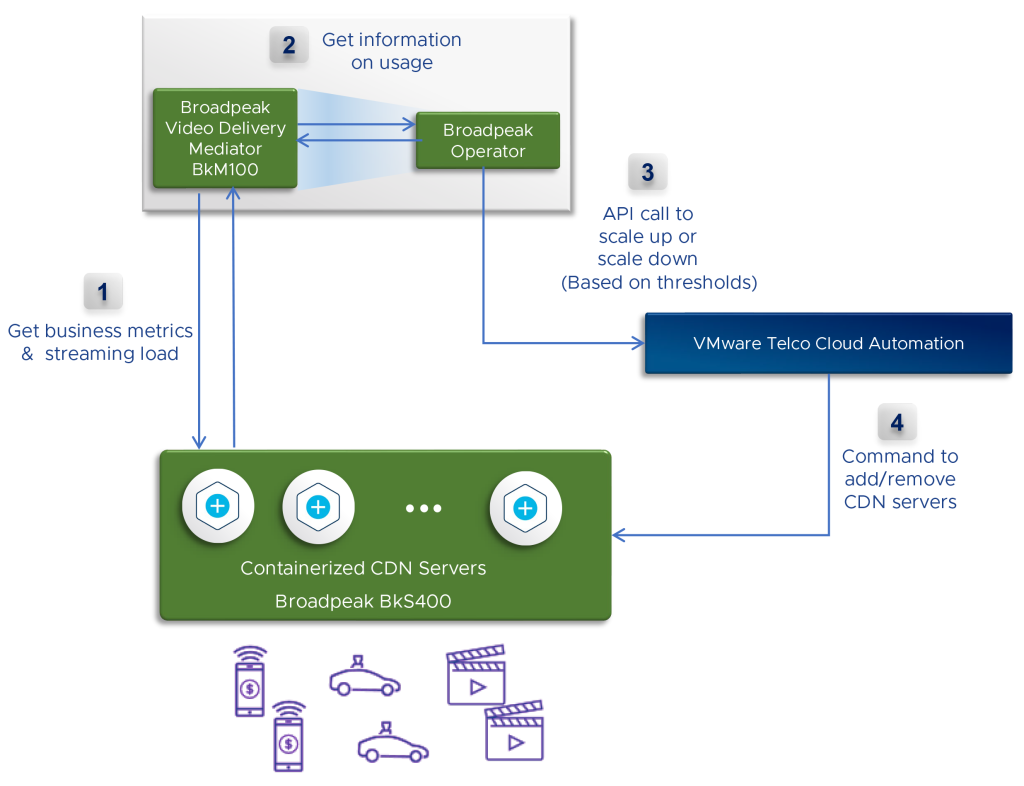In an increasingly omni-digital world, there has been a surge in consumption of digital content and consumers embracing the digital lifestyle. With the advent of 5G-enabled devices, it has become even more crucial for communication service providers (CSPs) to provide low latency infrastructure for seamless streaming of content over the air. The landscape in broadcasting video content is transitioning to personalized HTTP-based streaming, causing extraordinary loads on networks during live events or sporting matches. Content owners are shifting from CSP’s Pay-TV aggregation platforms to directly distributing their content over the internet. CDN streaming servers, which are provisioned at edge locations, cache content closer to users’ proximity to smooth out the viewing experience. However, CDN streaming servers are typically either under-provisioned or over-provisioned due to the guesswork involved in capacity planning.
Zero-touch automation is essential to unleash the potential of a business as it simplifies operations by reducing mundane and repetitive workflows. It plays a key role in keeping the quality of customer experience high for services like video streaming, which often utilizes the edge of networks, as operational complexities increase in distributed environments. Thus, simplicity through automation is the savior of operations.
Without elastic and flexible CDN infrastructure, CSPs experience the following problems in delivering content to users’ personal devices:
- Slow streaming of media content from centrally located servers accessed from distant locations
- Sudden spikes in website traffic gets concentrated on already overloaded servers, causing them to go down
- Slow performance of applications marks them on a low rank
- Over-provisioning of servers drives up capital expenses (CapEx)
- Higher power consumption of surplus servers running during less traffic, resulting in underutilization of resources
The foundational way out from these setbacks is a solution that dynamically scales streaming servers in an automated fashion based on real-time traffic conditions. VMware in collaboration with Broadpeak enables CSPs to deliver superior quality of experience (QoE) with scalable, containerized CDN environments.
Solution Overview:

As you see in the Figure 1 above, VMware Telco Cloud Platform offers highly scalable horizontal infrastructure to support value-add use cases like CDN. VMware Telco Cloud Automation, a key component of VMware Telco Cloud Platform, simplifies this effort by offering cloud-smart automation that can scale Broadpeak Advanced CDN network functions across clouds, in accordance with content popularity, traffic patterns, and business requirements. The open APIs of VMware Telco Cloud Automation enable seamless integration with network functions and applications that give control over the scaling of networks. Broadpeak open, dynamic and elastic Advanced CDN running on VMware Telco Cloud Platform is a one-stop solution that delivers always-on high quality streaming while keeping costs under control through intelligent CDN auto-scaling of containerized applications.
With 5G network adoption set to increase further, VMware and Broadpeak’s dynamically scalable CDN solution benefits CSPs by enabling them to offer efficient content delivery services. Nevertheless, besides increased speed and reliability subscribers get to view streaming content over the air unbuffered, while they are on the go.
Broadpeak Advanced CDN is composed of the following components:
- BkS400 Streaming Servers for caching and streaming the content.
- BkM100 Video Delivery Mediator that manages topology, allocates streams and monitors the system.
- Broadpeak Operator: A module of the Video Delivery Mediator that triggers scaling procedures through the open APIs of VMware Telco Cloud Automation based on business metrics such as the number of streaming sessions.
The following diagram shows the control flow between Broadpeak’s components and VMware Telco Cloud Automation for the automated scaling up of servers.

The streaming servers are scaled up when the number of connections reaches a defined threshold. The Broadpeak Operator then engages VMware Telco Cloud Automation to deploy new streaming servers, thereby increasing the capacity of the CDN.
A short video on the VMware and Broadpeak integration explains how resources are scaled dynamically.
As the number of users logged onto the BkS400 Streaming Servers reduces, the active sessions are cleared from the BkM100 Video Delivery Mediator, which then notifies the Broadpeak Operator to trigger the deletion of the no longer required BkS400 streaming server.
The following are the business benefits CSPs can take advantage of in creating a digital ecosystem built with VMware and Broadpeak:
- Simplify operations by dynamically scaling infrastructure up and down
- Control CapEx by right sizing the infrastructure
- Reduce OpEx with automated CDN scaling
- Accelerate the market entry with simplified CDN deployment and management
- Broadcast live content, large file delivery such as videos, downloads, and media-rich content to any device, anywhere
Conclusion
Digital technologies are the crux of the future world. They will bring value only if the infrastructure is rightly selected, deployed, and managed. A frictionless digital experience acts as a catalyst for business success, advocacy, customer loyalty and growth. Broadpeak’s open, dynamic, and elastic container based Advanced CDN harmoniously works with VMware Telco Cloud Platform. VMware Telco Cloud Automation which powers this cloud-smart solution, is a key component of VMware Telco Cloud Platform, that dynamically adjusts the underpinning infrastructure resources to deliver content and services according to the demand.
Discover more from VMware Telco Cloud Blog
Subscribe to get the latest posts sent to your email.








